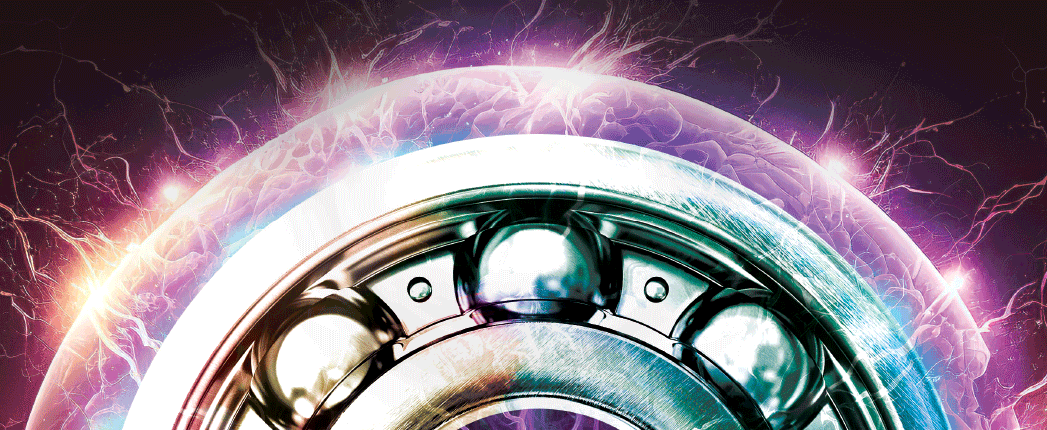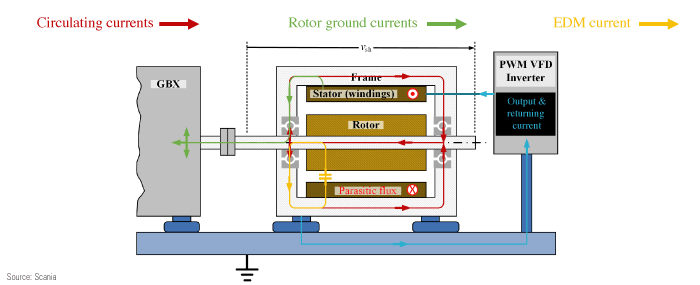
At first glance, lubricating an electric vehicle (EV) seems relatively simple. It doesn’t have many of the complicated parts and operating conditions that internal combustion engine vehicles do. Fewer moving parts means fewer types of lubrication are needed. No need to worry about ash or varnish or drain intervals.
However, a closer look reveals something to keep tribologists awake at night: electricity. When added to what are well-observed tribological phenomena, things get complicated.
“Electricity adds more challenges to the already very challenging discipline that is tribology,” Jonny Hansen, a technology lead and senior tribologist at Scania, told delegates at the ICIS World Base Oil and Lubricants conference held in the United Kingdom in May.
Hansen specializes in EV tribology, a relatively new field that will gather increasing attention as the size of the world’s EV fleet grows and the lubricants industry develops more products optimized for EVs.
In recent years, the automotive industry has seen a significant shift toward low-emissions transport, with battery EVs (BEVs) leading the charge. As BEVs become more prevalent, it is crucial to understand the unique challenges and considerations in their design and maintenance. One such critical area is how moving parts in the drivetrain, such as rolling element bearings, tolerate stray electric current.
Regimes
With EV motors rotating up to 20,000 revolutions per minute—four times faster their internal combustion engine counterparts—the stresses placed on the lubricant and bearings are extreme.
Understanding and predicting the lubrication regime—the physical state of the lubricant and contact surfaces at any given time—in all machines is critical. In an EV, it plays a large role in controlling unwanted electrical discharges from the very current that propels the vehicle to avoid damaging bearings or gears.
In a typical non-conforming contact (as found in rolling element bearings or gears), where two surfaces that do not fit perfectly move against each other with the help of a lubricant, a film of oil forms between them. Ideally, this film should be thicker than the surface roughness to prevent wear and damage. Conversely, as the lubricant is an electrical insulator, it should also not be in a range where electrical discharges can occur, or too thick by excessive viscosity.
Figure 1. Types of Bearing Currents

“It’s an optimization problem where one has to balance the risk of mechanical and electrical damages, and power efficiency,” Hansen said.
When contacts are at rest, there is close metal-on-metal contact and no resistance to current flow. As the sliding speed between contact areas increases, so does film thickness and resistance. Eventually, hydrodynamic lift occurs and a full film of lubricant separates the two surfaces, overcoming friction and wear.
The consequences of electrical discharges can be severe. These include pitting, frosting and fluting of the bearings. These surface problems are possible under lubrication conditions previously considered safe. This poses a new challenge for EV tribology.
A further special mode of lubrication has been identified in non-conforming contacts—elastohydrodynamic lubrication, or EHL. There is a full yet very thin film between contacts, and the movement of the lubricant between the contact surfaces deforms them from the very high pressure. As pressure increases, viscosity also increases—so much so that it resembles glass.
“This film thickness is very, very thin—from nanometers up to about 1 micrometer. So, it’s much thinner than the contact size itself,” Hansen said. “You cannot really see much at this scale—it’s like comparing the grass on a football pitch to the pitch itself.”
Lambda Star
On the microscopic level, surfaces are not smooth, and the oil layer must work under difficult conditions, leading to more friction and shorter lifespan. This is a concern because a significant portion of global energy consumption is due to friction and wear.
Existing methods can predict the thickness of the oil layer for smooth surfaces, but they are ineffective for rough surfaces, Hansen found.
The current model uses a parameter called the lambda (Λ) ratio. It is the original film parameter introduced in the 1960s and is the conventional approach used by lubrication engineers and researchers. The model is used to classify lubrication into different “regimes” based on the ratio of the oil film’s thickness to the roughness of the surfaces. However, this parameter is flawed when considering the gradual change in lubrication quality during operation due to running in and wear. It is therefore not a good approach for understanding when surface liftoff occurs and when bearing contact risks suffering electrical damages.
Hansen’s innovation is lambda star (Λ*)—a revised lambda parameter. This new parameter takes into account micro-level effects of the oil layer formed by roughness on the surfaces. Surface roughness, or asperities, are deformable under EHL pressure, and this deformation depends on the shape of asperities and affects the lubrication regime.
“We had to account for these effects to come up with a more accurate film parameter,” Hansen said. He is now applying it and developing it further for EV lubrication. Having tested it on real surfaces in a ball-on-disc setup, the results show that Λ* provides a considerably more accurate estimate of the lubrication quality compared with Λ.
In those tests, the parameter was verified by studying the changes in surface topography during the transition from mixed-to-full film elastohydrodynamic lubrication and by measuring when the contact became an electrical insulator.
Discharges
According to Hansen, the problems start with a particular yet essential part of an EV.
“For electro tribologists like me, the root of all evil starts at the source—the inverter,” he said.
The inverter converts the direct current supplied by the battery into alternating current that is used by the vehicle’s electric motor to propel the vehicle. It does this with a high frequency switch, typically in the range of kilohertz. A higher frequency means better efficiency but greater risk of unwanted electrical discharges. If those discharges happen in the bearing, the damage can be severe.
Hansen explained the electrical damage mechanisms to Lubes’n’Greases as follows:
Full film lubrication enables voltage build-up between raceways and rolling elements in rolling element bearings. When the voltage exceeds the breakdown voltage of the lubricant, an electrical arc discharge occurs. The breakdown voltage is an important parameter, too, as it is the threshold at which a voltage forces itself through the insulator—the lubricant film.
The arc has a relatively high energy density because of the small Hertzian contact (and asperities) as well as the applied voltage and current, which are relatively small in the order of amps and volts. The arc creates a small micrometer-sized pit in the raceway by melting and releasing material.
This molten steel mixed with oil may result in quenching, thus changing the material structure around the pitted area. This scenario is a precursor to reduced rolling contact fatigue life due to the high contact pressures, which typically are more than 1 gigapascal.
In addition, because of the high switching frequency of the inverter, discharge events happen many times per second. This results in many small pits evenly distributed over the raceway area. To the naked eye, they look like a gray band, and so is typically called electrical frosting. Over time, frosting becomes electrical fluting, which appears as corrugation marks, or micrometer deep furrows. These furrows are many times deeper than the fluid film thickness. This leads to fluid film collapse, and rolling contact fatigue life is reduced further. In the worst case, seizure occurs from scuffing.
Electrical discharges are the primary damage mode, while the tribological conditions of high pressure and sliding, etc., are secondary damage modes that eventually cause bearings to prematurely fail by rolling contact fatigue or, even worse, seizure.
“Understanding under what conditions EHL occurs is therefore of substantial importance and this we can do with lambda star and, by extension, we can model the capacitive behavior of bearings,” Hansen told Lubes’n’Greases.
Future Direction
The choice of lubricant and the optimization of lubrication conditions significantly impact the performance and durability of EVs. Achieving the right balance between viscosity, film thickness and surface roughness is crucial to minimize wear, friction and electrical discharge damages.
“In addition to the importance of viscosity, due to the electrical discharges in the full film lubrication regime, it is very important also to understand lubricants’ and tribo-films’ electric and dielectric properties. I think this is a research field that needs considerable effort in the coming years,” Hansen told Lubes’n’Greases.
By carefully selecting lubricants with the appropriate electrical properties and optimizing lubrication parameters, manufacturers can enhance the efficiency and longevity of EV drivetrains.
This presents a new set of challenges for tribologists, who must now focus on electronic tribology to optimize lubrication against wear and electrical discharges simultaneously.
The field of EV tribology is still evolving, with ongoing research aiming to address emerging challenges. Researchers are exploring the relationship between lubricant properties, surface roughness and the occurrence of discharges in EV contacts.
Additionally, efforts are being made to refine and validate new parameters that offer better estimations of the transition between lubrication regimes.
EV tribology is at an intersection between mechanical and electrical sciences, providing insights into the performance, efficiency and durability of EV drivetrains.
As EVs become more sophisticated, predicting the interactions between electrical and mechanical phenomena in tribological systems will further advance EV technology. This will allow tribologists to develop optimized solutions for EVs.
“It’s very important to be able to estimate the transition between each extreme rotation regime, and that can be done with a new film parameter,” Hansen said.
Simon Johns is an editor with Lubes’n’Greases. Contact him at Simon@LubesnGreases.com.